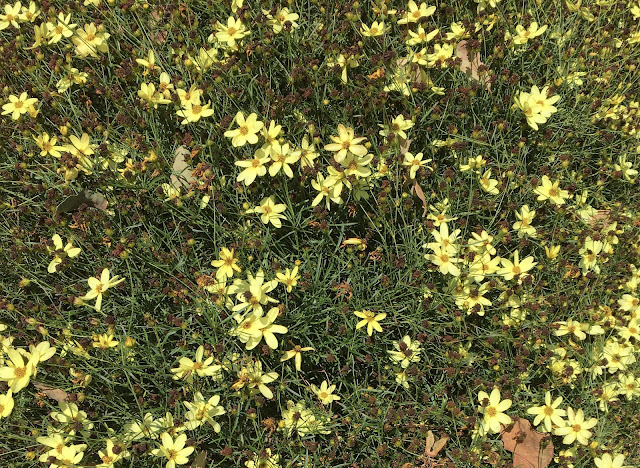
Morning and late afternoon events showcase blooming Horticulture Center

|
|
See what's blooming at the Fair Oaks Horticulture Center this Saturday morning
or on the afternoon of Wednesday, May 18. (Photo: Kathy Morrison)
|
Weather swings notwithstanding, May is gorgeous at the Fair Oaks Horticulture Center. Over the next seven days, the Sacramento County master gardeners offer two opportunities to view the demonstration garden at its spring best.
This Saturday, May 14, the Open Garden will be at the usual time: 9 a.m. to noon. Then on Wednesday, May 18, for the first time FOHC will be open from 4 p.m. to 7 p.m., for visitors coming home from work or school, or folks interested in a pleasant stroll before dinner. At both events, all areas of the one-acre Horticulture Center will be staffed, with master gardeners ready to answer all types of gardening questions.
Expect to see plenty of pollinators in the Water Efficient Landscape area. Master gardeners there are creating a model wildlife habitat garden for a home landscape with plantings, bee and bird houses. In the Orchard, crop thinning will be taking place. Ask about fighting pests such as codling moth!
The Vegetable Garden will have the burgeoning summer crops on view. The Compost Area team will offer tips for success, as well as answer questions on California's new composting law. (That goes into effect in July.) The Berry Area, Herb Garden and Vineyard also will be busy -- it's that time of year!
Water use is of course a big topic for gardeners. Throughout the Horticulture Center, visitors will see ways to use water more wisely with mulch, irrigation techniques and water-efficient landscaping.
The Fair Oaks Horticulture Center is at 11549 Fair Oaks Blvd., Fair Oaks, south of Fair Oaks Park and Madison Avenue.
For more information or directions to the Open Garden days, go to https://sacmg.ucanr.edu/ .
-- Kathy Morrison
Comments
0 comments have been posted.Sacramento Digs Gardening to your inbox.
Food in My Back Yard Series
April 22: Should you stock up on fertilizer? (Yes!)
April 15: Grow culinary herbs in containers
April 8: When to plant summer vegetables
April 1: Don't be fooled by these garden myths
March 25: Fertilizer tips: How to 'feed' your vegetables for healthy growth
March 18: Time to give vegetable seedlings some more space
March 11: Ways to win the fight against weeds
March 4: Potatoes from the garden
Feb. 25: Plant a fruit tree now -- for later
Feb. 18: How to squeeze more food into less space
Feb. 11: When to plant? Consider staggering your transplants
Feb. 4: Starting in seed starting
Sites We Like
Garden Checklist for week of April 27
Once the clouds clear, get to work. Spring growth is in high gear.
* Set out tomato, pepper and eggplant transplants.
* From seed, plant beans, beets, cantaloupes, carrots, corn, cucumbers, melons, pumpkins, radishes and squash. Plant onion sets.
* In the flower garden, plant seeds for asters, cosmos, celosia, marigolds, salvia, sunflowers and zinnias. Transplant petunias, zinnias, geraniums and other summer bloomers.
* Plant perennials and dahlia tubers for summer bloom. Late April is about the last chance to plant summer bulbs, such as gladiolus and tuberous begonias.
* Transplant lettuce and cabbage seedlings.
* Weed, weed, weed! Don’t let unwanted plants go to seed.
* April is the last chance to plant citrus trees such as dwarf orange, lemon and kumquat. These trees also look good in landscaping and provide fresh fruit in winter.
* Feed citrus trees with a low dose of balanced fertilizer (such as 10-10-10) during bloom to help set fruit. Keep an eye out for ants.
* Apply slow-release fertilizer to the lawn.
* Thoroughly clean debris from the bottom of outdoor ponds or fountains.
* Start thinning fruit that's formed on apple and stone fruit trees -- you'll get larger fruit at harvest (and avoid limb breakage) if some is thinned now. The UC recommendation is to thin fruit when it is about 3/4 of an inch in diameter. Peaches and nectarines should be thinned to about 6 inches apart; smaller fruit such as plums and pluots can be about 4 inches apart. Apricots can be left at 3 inches apart. Apples and pears should be thinned to one fruit per cluster of flowers, 6 to 8 inches apart.
* Azaleas and camellias looking a little yellow? If leaves are turning yellow between the veins, give them a boost with chelated iron.
* Trim dead flowers but not leaves from spring-flowering bulbs such as daffodils and tulips. Those leaves gather energy to create next year's flowers. Also, give the bulbs a fertilizer boost after bloom.
* Pinch chrysanthemums back to 12 inches for fall flowers. Cut old stems to the ground.
* Mulch around plants to conserve moisture and control weeds.